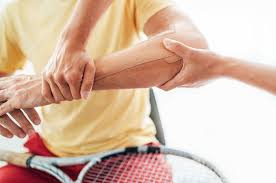Understanding Epicondylitis (Tennis elbow or Golfer’s elbow): Causes, Symptoms, and Treatment

Epicondylitis, commonly known as tennis elbow or golfer’s elbow, is a condition that affects the tendons connecting the forearm muscles to the elbow. It is characterized by pain and inflammation around the bony prominences on the inside or outside of the elbow. This article aims to provide a comprehensive overview of epicondylitis, including its causes, symptoms, and available treatment options.
Causes of Epicondylitis:
Epicondylitis is primarily caused by repetitive or strenuous activities that involve the forearm muscles. Some common causes include:
a) Tennis Elbow (Lateral Epicondylitis):
Repeatedly gripping and twisting movements of the wrist, such as those involved in playing tennis, racquetball, or other racquet sports. It can also be caused by repeated movements from cleaning, manual work, or even using a mouse or typing.
There is more risk of injury if there is improper technique while performing activities like weightlifting, painting, or using hand tools.
b) Golfer’s Elbow (Medial Epicondylitis):
Repetitive wrist flexion and forceful gripping actions, commonly associated with golf swings, throwing sports, or activities involving repetitive wrist movements.
Symptoms of Epicondylitis:
The symptoms of epicondylitis may develop gradually over time, and individuals may experience the following:
a) Tennis Elbow:
Pain and tenderness on the outside of the elbow that may radiate down the forearm.
Weakness in the affected arm, making it difficult to grip or lift objects.
Increased pain when performing activities that involve wrist extension or gripping.
b) Golfer’s Elbow:
Pain and tenderness on the inside of the elbow that may extend to the forearm.
Weakness in the affected arm, particularly when gripping or flexing the wrist.
Increased pain when performing activities that involve wrist flexion or gripping.
Treatment Options:
- Non-Surgical Treatment:
Rest and activity modification: Avoiding activities that exacerbate the symptoms and allowing the affected area to rest and heal.
Pain relief: Over-the-counter nonsteroidal anti-inflammatory drugs (NSAIDs) can help reduce pain and inflammation.
Physical therapy: Specific exercises and stretches can strengthen the forearm muscles, improve flexibility, and promote healing in a more durable way, in order to prevent reinjury once return to sport or return to daily activity.
Dry Needling: Can decrease inflammation and pain in short term, making your physical therapy exercises easier to tolerate. It also promote tissue healing, release tense muscles.
Bracing or splinting: Wearing a brace or splint can provide support and relieve stress on the injured tendons. - Injection:
If the conservatives treatments are not working well, your physical therapist and your doctor may suggest either an cortisone injection or PRP injection to help resolve inflammation and pain, while continuing your physiotherapy exercises and treatments. - Surgical Treatment (last resort):
In severe or chronic cases where conservative measures fail, surgical intervention may be recommended. The procedures involve removing damaged tissue, repairing the tendon, or releasing tension on the affected tendons. It is usually used when there is actual damage of the tendon.
Prevention and Rehabilitation:
- Proper technique and equipment: Using correct techniques and equipment while participating in sports or performing repetitive tasks can reduce the risk of developing epicondylitis.
- Gradual progression: Gradually increasing the intensity and duration of activities can help prevent overuse injuries.
- Warm-up and stretching: Prior to engaging in physical activities, warming up and performing proper stretching exercises can prepare the muscles for the stress they will endure.
- Ergonomics: Maintaining proper posture and ergonomics during work or daily activities can reduce strain on the forearm muscles.
- Rehabilitation: Following a period of rest and recovery, gradually reintroducing exercises and activities under the guidance of a healthcare.
Book an appointment with our physical therapist if you have Tennis Elbow or Golfer’s Elbow, because we can HELP you!


Recent Comments